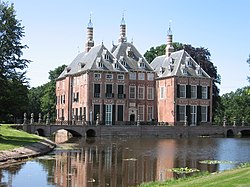
Oostkamp is a municipality located in the Belgian province of West Flanders. The municipality comprises the villages of Hertsberge, Oostkamp proper, Ruddervoorde and Waardamme. On January 1, 2019, Oostkamp had a total population of 23,698. The total area is 79.65 km² which gives a population density of 289 inhabitants per km².

Loevestein Castle is a medieval castle in the municipality of Zaltbommel, Gelderland, the Netherlands.

Muiden Castle is a castle in the Netherlands, located at the mouth of the Vecht river, some 15 kilometers southeast of Amsterdam, in Muiden, where it flows into what used to be the Zuiderzee. It is one of the better known castles in the Netherlands and featured in many television shows set in the Middle Ages.

The Fraeylemaborg is a borg in the village of Slochteren in the Netherlands. At present the Fraeylemaborg is a historic house museum. The museum had 31,509 visitors in 2013.

Heeze Castle is situated in the Netherlands, south of Eindhoven. It used to be the centre of the seigneury of Heeze, Leende and Zesgehuchten, part of the Duchy of Brabant. In the Middle Ages, it was owned by the de Horne family. In the seventeenth Century Pieter Post designed a new castle, of which the first part was built in 1665. After Pieter Post died, the work was completed by his son Maurits Post.

Valkenburg Castle is a ruined castle in Valkenburg aan de Geul, Netherlands. It is unique in the Netherlands in that it is the only castle in the country built on a hill. The castle is listed in the top hundred of Dutch cultural monuments.

Baroness Gratia Maria Margretha, Baroness Schimmelpenninck van der Oye was a Dutch alpine skier. Her father was president of the Dutch National Olympic Committee during the 1928 Summer Olympics in Amsterdam and a long-term member of the International Olympic Committee. Gratia reached sixth place at the world championships and won two major ski races, in St. Anton and Kitzbühel. She competed at the 1936 Winter Olympics in Garmisch-Partenkirchen, finishing 14th in the alpine combined event. Despite her two falls, this remains the highest ranking in Olympic skiing reached by a Dutch national.

Doorwerth Castle is a medieval castle situated on the river Rhine near the city of Arnhem, Netherlands.

Floris Adriaan van Hall, Baron of Hall was a prominent Dutch nobleman and statesman in the 19th century. He played an important role as representative of the Amsterdam trade and banking sector, and later as politician. He served as Prime Minister of the Netherlands from 1853 to 1856, and again from 1860 to 1861.
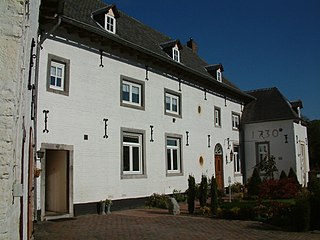
Jansgeleen Castle, now erroneously called Sint-Jansgeleen or Sint Jansgeleen, was a medieval castle in the little village of Spaubeek, in the Dutch province of Limburg. Spaubeek is located in the municipality of Beek, about 3 km south of the town of Geleen. Spaubeek was a separate municipality until 1982, when it was merged with Beek.

Van Wassenaer is the name of an old Dutch noble family. It was first mentioned in the county of Holland on November 3, 1200. They are one of the few original noble families from Holland that has survived to this day. Members of the family carry the title of count or baron.
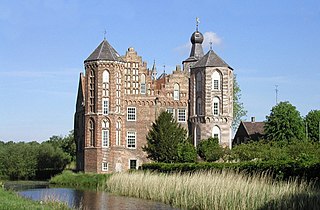
The castle Croy is a castle in the Dutch province North Brabant, near the village Aarle-Rixtel which is part of the municipality of Laarbeek. From 1642 until 1968 Croy belonged to the municipality Stiphout.
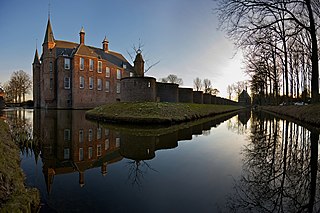
Zuylen Castle is a Dutch castle at the village of Oud-Zuilen just north of the city of Utrecht. It is located along the river Vecht at the southern end of the Vechtstreek.

Breda Castle is a castle in the city of Breda, in the Netherlands.

Huis Bergh is a castle in 's-Heerenberg and is one of the largest castles in the Netherlands. It gives its name to the Land van den Bergh and was previously owned by the counts van Bergh.

Egmond Castle, also called the Ruins of Egmond, is a ruined medieval castle in the Dutch province of North Holland. It is located in Egmond aan den Hoef in the municipality of Bergen and lies about 7 kilometres (4.3 mi) west of Alkmaar. The castle dates from the 11th century and is the ancestral seat of the Egmond family, whose members became sovereign Dukes of Guelders, Counts of Egmond and Princes of Gavere, Counts of Buren and Leerdam. It is a national monument of the Netherlands.

The Van Polanen family are a noble family that played an important role in the Netherlands during the Middle Ages. By inheriting the vast properties of the Polanen family, the House of Nassau in 1403 became a landowner in the Netherlands for the first time.
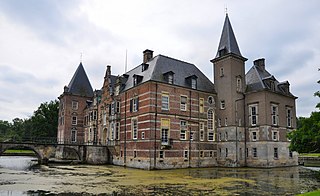
Twickel is a protected historic country estate with 81 complex parts near Delden in the hamlet of Deldeneresch, in the municipality of Hof van Twente in the province of Overijssel in The Netherlands. The moated castle forms the center.
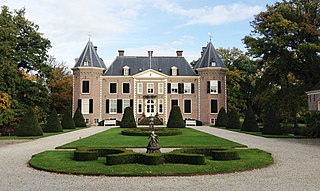
Nijenhuis is a castle and an estate near Diepenheim in the municipality Hof van Twente, Netherlands.
